|
This section contains 859 words (approx. 3 pages at 400 words per page) |

|
Chapter 6 Summary and Analysis
In chapter six, from the moment the war began, slaves began to escape and to make their way to the north or to northern held military forts. Although the country was at war, the Fugitive Slave Law was still in effect, and many of these slaves were sent back to their home states even if it meant sending them back into bondage. However, on May 23, 1861, at Fortress Monroe, General Benjamin F. Butler decided not to send a group of escape slaves back to their owners. Instead, Butler, citing a need for more manpower, declared slaves contraband of war, allowing him to keep them. Butler soon had dozens of slaves coming to him. Lincoln was made aware of what Butler had done and approved, but he could not publicly support him. For this reason, other commanders of Northern held forts were left...
(read more from the Chapter 6 Summary)
|
This section contains 859 words (approx. 3 pages at 400 words per page) |

|




